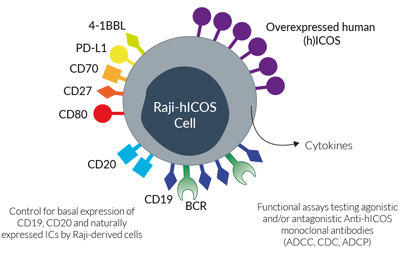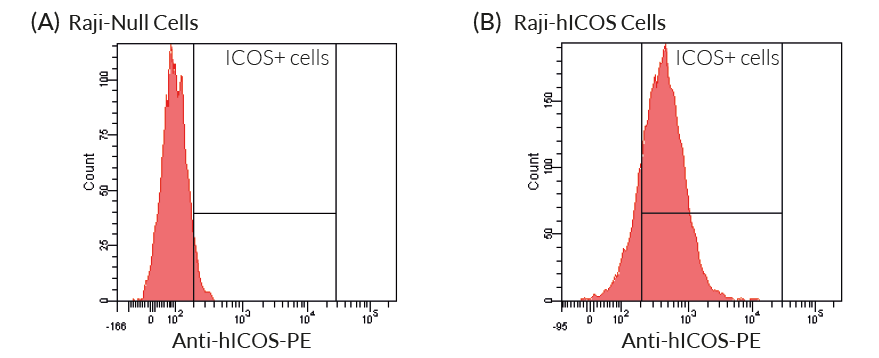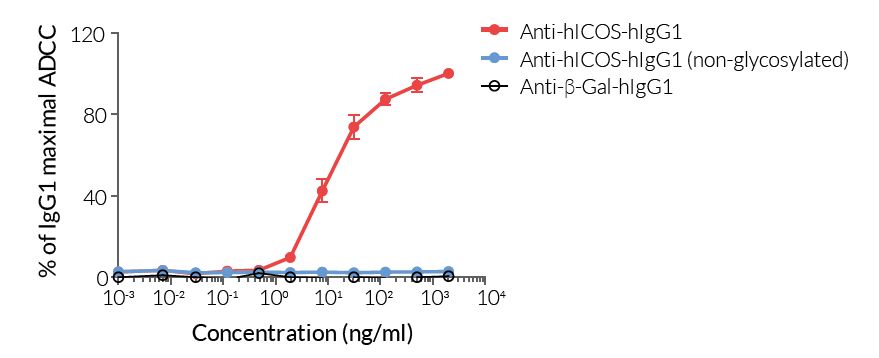Human ICOS-expressing Raji Cells
| Product | Unit size | Cat. code | Docs. | Qty. | Price | |
|---|---|---|---|---|---|---|
|
Raji-hICOS Cells Human lymphoblast cells - ADCC ICOS Target Cells |
Show product |
3-7 x 10e6 cells |
raji-hicos
|
|
||
|
Raji-hICOS vial Additionnal cell cial |
Show product |
3-7 x 10e6 cells |
raji-hicos-av
|
Notification:
Reference #raji-hicos-av can only be ordered together with reference #raji-hicos.
Human ICOS-expressing B cells
Raji-hICOS cells were developed from the human Raji cell line, a human B lymphocyte-derived cell line, and engineered to stably overexpress the human ICOS gene. Raji cells have been successfully used as target cells in human effector studies such as antibody-dependent cellular cytotoxicity (ADCC), either with peripheral blood mononuclear cells, natural killer (NK) cells, or T cell-derived Jurkat reporter cells.
Inducible Co-stimulator (ICOS, CD278) is a co-stimulatory immune checkpoint (IC) and a member of the CD28 superfamily. Expression of ICOS is rapidly induced in CD4+ and CD8+ T cells upon their activation, whereas its ligand ICOSL (also known as CD275), is mostly expressed on antigen-presenting cells [1]. The interaction between ICOS and ICOSL delivers a secondary co-stimulatory signal through the activation of the transcription factor AKT, which promotes T cell proliferation and differentiation as well as the production of cytokines [1]. In tumor immunity, ICOS is involved in the amplification of the anti-tumor cytotoxic CD8+ T cell response, as well as the 'pro-tumor' function and maintenance of regulatory T cells (Tregs). Therefore, both agonistic and antagonistic monoclonal antibodies (mAbs) targeting this pathway are being investigated in combinational cancer immunotherapy [2]. Notably, ICOS agonistic mAbs have been shown to potentiate the effects of anti-CTLA-4 mAbs [3].
Features of Raji-hICOS cells:

Surface expressed markers and ICs in Raji-hICOS cells
- Stable overexpression of the human ICOS gene
- Characterized by a number of cell-surface expressed markers including the B cell receptor (BCR), CD19, and CD20
- Constitutive expression of various immune checkpoints (ICs) such as CD27, CD70, CD80, PD-L1, and 4-1BBL
Applications for Raji-hICOS cells:
- Target cell line for ADCC assays using InvivoGen's Jurkat-Lucia™ NFAT-CD16 cells
- Target cell line for cell toxicity assays using NK or CAR-T cells
- For use in the development of novel human ICOS agonistic and antagonistic mAbs
Validation of Raji-hICOS cells:
- Overexpression of ICOS verified by flow cytometry
- Functionally tested as target cells in ADCC assays using anti-human ICOS mAbs and Jurkat-Lucia™ NFAT-CD16 cells
- Guaranteed mycoplasma-free
References:
1. Amatore, F. et al. 2020. Role of ICOS in cancer immunotherapy. Expert Opin Biol Ther 20, 141-150.
2. Solinas, C. et al. 2020. The rationale behind targeting the ICOS-ICOS ligand costimulatory pathway in cancer immunotherapy. ESMO Open 5.
3. Soldevilla, M.M. et al. 2019. ICOS Costimulation at the Tumor Site in Combination with CTLA-4 Blockade Therapy Elicits Strong Tumor Immunity. Mol Ther 27, 1878-1891.
Specifications
Antibiotic resistance: Blasticidin
Growth medium: IMDM, 2 mM L-glutamine, 25 mM HEPES, 10% heat-inactivated fetal bovine serum (FBS; 30 min at 56 °C), Pen-Strep (100 U/ml-100 µg/ml), 100 µg/ml Normocin™
Test medium: IMDM, 2 mM L-glutamine, 25 mM HEPES, 10% heat-inactivated FBS, Pen-Strep (100 U/ml-100 µg/ml)
Quality control:
- Human ICOS expression has been verified by flow cytometry.
- Induction of antibody-dependent cellular cytotoxicity (ADCC) has been validated using anti-hICOS antibodies and InvivoGen's Jurkat-NFAT Lucia™ CD16 reporter cell line.
- The stability for 20 passages following thawing has been verified.
- Raji-hICOS cells are guaranteed mycoplasma-free.
Contents
- 3-7 x 106 Raji-hICOS cells in a cryovial or shipping flask.
- 1 ml of Blasticidin (10 mg/ml). Store at 4 °C or at -20 °C.
- 1 ml of Normocin™ (50 mg/ml). Normocin™ is a formulation of three antibiotics active against mycoplasmas, bacteria, and fungi. Store at -20 °C.
IMPORTANT: If cells are shipped frozen (i.e. in a cryovial) and are not frozen upon arrival, contact InvivoGen immediately.
![]() Shipped on dry ice (Europe, USA & Canada)
Shipped on dry ice (Europe, USA & Canada)








